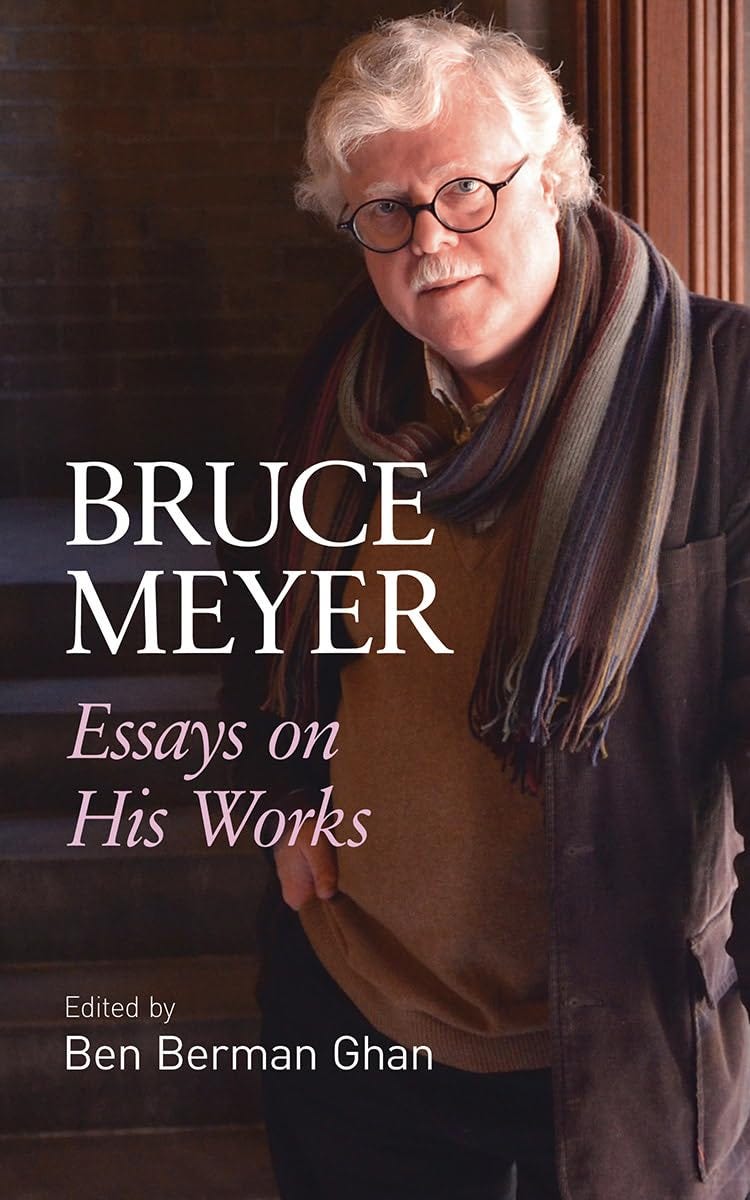Bruce Meyer: Essays on His Works Edited by Ben Berman Ghan
Reviewed by Lisa Timpf
Bruce Meyer has written or edited more than 70 books of poetry, fiction, and nonfiction over a long and distinguished teaching and writing career. Bruce Meyer: Essays on His Works, edited by Ben Berman Ghan, includes 14 essays that provide a multi-faceted look at Meyer’s works and his contributions to the Canadian literary scene.
Bruce Hunter, who describes Meyer as “a literary force of nature,” comments on Meyer’s poetry collection Dog Days. Juan de Dios Torralbo-Caballero talks about Meyer’s book 1967: Centennial Year, while also providing a context around Meyer’s childhood years, the importance of family in Meyer’s life, Canadian politics, and other topics.
An essay titled “Meyer and Mexico” by Colin Carberry discusses a trip Meyer took to Mexico to attend a conference, and how he was so impressed by the Mexican city of Linares that he wrote a series of poems inspired by his stay there. These poems were translated into Spanish and published as a bilingual English/Spanish book To Linares, described by Carberry as “a magical book that involved hundreds and hundreds of people.”
David Stover writes of “Bruce Meyer’s Adventures in the Invisible Trade.” The essay’s title refers to Canadian textbook publishing, and Stover discusses Meyer’s forays into that world, editing The Stories: Contemporary Short Fiction Written in English, published by Prentice-Hall Canada in 1996, and The Reader: Contemporary Essays and Essay Strategies, which was co-edited by Meyer’s sister Carolyn Meyer.
David Wevill, in “A Poet, Yes: The Poetry of Bruce Meyer” discusses poems from Meyer’s collections Anywhere (2000), The Spirit Bride (2002) and Oceans (2004). Describing some poems as “narrative meditations” and others as “luminous personal lyrics rooted in intimate emotion,” Wevill discusses the art of poetry as exhibited by Meyer’s poems, with features such as the deliberate use of sound, contrasts, imagery, rhyme, meter, and other features. Wevill comments on Meyer’s “skill at braiding the elemental, the mythical, with the domestic present, without traducing the value of either,” referring to Meyer as “a talented and graceful poet.”
Elana Wolff’s essay in “On Editing Bruce Meyer, or, Bruce Meyer on Editing” includes some of Meyer’s thoughts about poetry writing, and formatting and arranging collections. In “Chronicles of a Co-author” H. Masud Taj talks about his experiences collaborating with Meyer. The book also includes eminent Canadian author and scholar George Elliott Clarke’s essay “On Bruce Meyer’s Unobtrusive Excellence.”
“Bruce Meyer: an interview with Laurence Hutchman” explores Meyer’s thoughts about writing, while “Professor Bruce Meyer: Teacher of Poetry” by Antonia Facciponte gives a sense of what it was like to be a student in Meyer’s classes. These are just a shortlist of the topics discussed in Bruce Meyer: Essays on His Works.
The book provides multiple perspectives, enabling the reader to see Meyer from different angles: poet, mentor, teacher, friend, and co-author among them. We learn about Meyer’s writing from the outside, from others commenting on his works, and from the inside, from Meyer’s own views: the Hutchman essay, for example, includes discussions about Meyer’s youth, other Canadian writers and thinkers who influenced his writing, his thoughts on Canadian literature, and other topics.
The book’s final essay, “In Conversation: Ben Ghan and Bruce Meyer on The Chronicle of Magpies and other Works” further builds on Meyer’s career, the importance of family in his writing, and the nature of stories.
Bruce Meyer: Essays on His Works provides reader with a view of Meyer that goes beyond dry facts. Many of the writers express respect, admiration for Meyers’ writing, and appreciation for the impact he has had on their own endeavours.
The essay collection functions like a kaleidoscope, showing the reader, with each flip of the chapter, a different facet of the same Bruce Meyer. You don’t have to be intimately acquainted with Meyer’s work to enjoy this book, though those who are familiar with his writing will likely have some additional appreciation of the comments made.
While writing about Meyer’s writing and teaching, many of the contributors also comment on what makes for good writing. This makes the book of interest not only to those interested in Canadian literature, but also to writers looking to hone their craft.
About the Author
Ben Berman Ghan (he/him) is a writer and editor whose work has been featured in Clarkesworld Magazine, Strange Horizons, The Temz Review, Abyss and Apex, Pinhole Poetry, and others. He is the author of the novel The Years Shall Run Like Rabbits (Buckrider Books 2024), the novella Visitation Seeds (845 Press 2020), and the short story collection What We See in the Smoke (Crowsnest Books 2019). He has served on several literary magazines and is currently a prose editor for Wrong Publishing. Originally from Toronto, he now lives and writes in Calgary Alberta, where he is pursuing a PhD in English Literature at The University of Calgary.
About the Reviewer
Lisa Timpf is a retired HR and communications professional whose poetry has appeared in Eye to the Telescope, Star*Line, Triangulation: Seven-Day Weekend, and other venues. Lisa’s speculative poetry collection Cats and Dogs in Space is available from Hiraeth Publishing. You can find out more about Lisa’s writing projects at http://lisatimpf.blogspot.com/. Lisa is also on Bluesky, @lisatimpf.bsky.social
Book Details
Publisher: Guernica Editions (Essential Writers)
Language: English
Paperback: 200 pages
ISBN-10: 1771839341
ISBN-13: 978-1771839341




